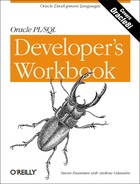Chapter 9. Object Technology
Oracle8 ushered us into the brave new world of object-oriented programming. . .almost. Since Oracle is, after all, a relational database, much of the object technology introduced in the Oracle8 (as well as the Oracle8i) release is a hybrid between true object data and relational data. The CREATE TYPE command, for example, looks suspiciously like a familiar record or table, with the exception that you can now include methods (procedures and functions) that act on the object’s attributes (columns and fields). This chapter tests your understanding of object types and your ability to apply object-oriented principles when designing a data structure.
Beginner
Intermediate
Expert
..................Content has been hidden....................
You can't read the all page of ebook, please click here login for view all page.
